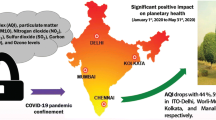Abstract
The objective of this paper is to study the change in ambient concentration of three of the standard criteria pollutants namely respiratory suspended particulate matters (RSPM or PM10), sulfur dioxide (SO2) and nitrogen dioxide (NO2) because of lockdown due to COVID-19 pandemic. It is studied for three locations viz. residential, industrial and commercial in and around the Nagpur city. The data has been collected from January to June 2020, where there was a normal situation from January to March for three months and a complete lockdown from April to June 2020 for three months. The monthly average concentrations of all three pollutants during the normal situation and lockdown period have been compared. It is found that the average concentration of all three pollutants at all the three locations is reduced by about 42–66% due to the lockdown. During the lockdown period the average concentration of SO2 was reduced to 5 µg/m3 from 14 µg/m3 in the normal situation. The average concentration of nitrogen dioxide (NO2) was reduced to 12 µg/m3 from 39 µg/m3 and the average concentration of RSPM reduced to 72 µg/m3 from 133 µg/m3 due to lockdown. It is observed that the concentration of all the pollutants during lockdown was below the prescribed CPCB standards. Air quality index (AQI) at all three locations improved from the range of 101–200 in the normal situation to 51–100 in the lockdown period. The quality of ambient air changed from MODERATE to SATISFACTORY. The reduction of pollutants is mainly due to the shutdown of anthropogenic activities in all three locations in and around Nagpur.
Access this chapter
Tax calculation will be finalised at checkout
Purchases are for personal use only
Similar content being viewed by others
References
Guttikunda SK, Goel R (2013) Health impacts of particulate pollution in a megacity-Delhi, India. Environ Dev 6(1):8–20
Gulia S, Shiva Nagendra SM, Khare M, Khanna I (2015) Urban air quality management—a review. Atmos Pollut Res 6(2):286–304
Pal A, Kulshreshtha K, Ahmad KJ, Yunus M (2000) Changes in leaf surface structures of two avenue tree species caused by auto-exhaust pollution. J Environ Biol 21(1):15–21
Patni S, Student PG (2017) Motor vehicle traffic congestion costing in Nagpur City. Int J Civ Eng Technol 8(4):100–106
Ristovski ZD et al (2012) Respiratory health effects of diesel particulate matter. Respirology 17(2):201–212
Pollution C, Board C, Environment MOF (1974) Environmental laboratories. Environ Sci Technol 8(10):888
A World Bank report (2016). The cost of air pollution: Strengthening the economic case for action – A world bank report. http://documents.worldbank.org/curated/en/781521473177013155/The-cost-of-airpollution-strengthening-the-economic-case-for-action
CPCB (2016) Air pollution of Delhi: an analysis. ENVIS Cent Control Pollut (Water Air Noise), 1–26
Pizzorno J, Crinnion W (2017) Particulate matter is a surprisingly common contributor to disease. Integr Med 16(4):8–12
West PW, Gaeke GC (1956) Fixation of sulfur dioxide as disulfitomercurate (II) and subsequent colorimetric estimation. Anal Chem 28(12):1816–1819
Kleine Deters J, Zalakeviciute R, Gonzalez M, Rybarczyk Y (2017) Modeling PM2.5 Urban pollution using machine learning and selected meteorological parameters. J Electr Comput Eng 2017:1–14. https://doi.org/10.1155/2017/5106045 (Article ID 5106045)
Chan AT (2002) Indoor-outdoor relationships of particulate matter and nitrogen oxides under different outdoor meteorological conditions
Ganguly R, Batterman S, Isakov V, Snyder M, Breen M, Brakefield-Caldwell W (2015) Effect of geocoding errors on traffic-related air pollutant exposure and concentration estimates. J Expo Sci Environ Epidemiol 25(5):490–498
Muxworthy AR, Matzka J, Petersen N (2001) Comparison of magnetic parameters of urban atmospheric particulate matter with pollution and meteorological data. Atmos Environ 35(26):4379–4386
IS 5182-23 (2006) Methods for measurement for air pollution, part 23: respirable suspended particulate matter (PM 10), cyclonic flow technique. Bureau of Indian Standards, New Delhi, pp 4–12
IS 5182-2 (2001) Methods for measurement for air pollution, part 2, sulphar dioxide. Bureau of Indian Standards, New Delhi, pp 4–15
IS 5182-6 (2006) Methods for measurement for air pollution, part 6, oxides of nitrogen.Bureau of Indian Standards, New Delhi, pp 4–12
Acknowledgments
The authors would like to thank the Director VNIT, Nagpur for his support and anchorage, Central Pollution Control Board (CPCB), New Delhi and Maharashtra Pollution Control Board (MPCB), Mumbai for sponsoring the projects under National Air Quality Monitoring Programme (NAMP) and State Air Quality Monitoring Programme (SAMP). Thanks to MPCB Regional Office, Nagpur for providing support. Thanks, Dr. V.A. Mhaisalkar, Professor in Civil Engg. (Rtd.) for his support, Mrs. Rekha Khadse for analyzing the air samples, Rashmi Vishwakarma for providing office assistance and Mr. Krushnakumar B. Bisen and Mr. Shivkumar M. Tembhre for providing help in sampling.
Author information
Authors and Affiliations
Editor information
Editors and Affiliations
Rights and permissions
Copyright information
© 2022 The Author(s), under exclusive license to Springer Nature Singapore Pte Ltd.
About this paper
Cite this paper
Saini, D., Darla, U.R., Lataye, D.H., Motghare, V.M., Ravendiran, E. (2022). Impact of Lockdown on Ambient Air Quality in Nagpur Due to COVID-19 Pandemic. In: Laishram, B., Tawalare, A. (eds) Recent Advancements in Civil Engineering. ACE 2020. Lecture Notes in Civil Engineering, vol 172. Springer, Singapore. https://doi.org/10.1007/978-981-16-4396-5_43
Download citation
DOI: https://doi.org/10.1007/978-981-16-4396-5_43
Published:
Publisher Name: Springer, Singapore
Print ISBN: 978-981-16-4395-8
Online ISBN: 978-981-16-4396-5
eBook Packages: EngineeringEngineering (R0)




